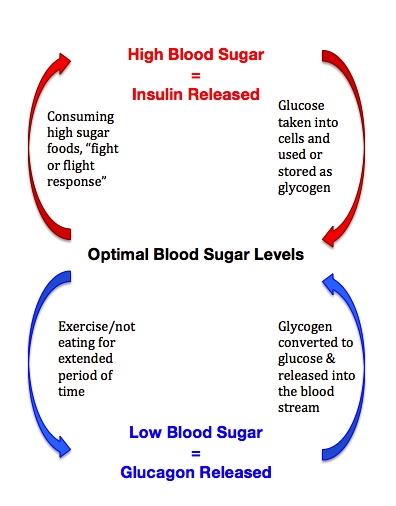

We will discuss homeostasis in every subsequent system. This section will review the terminology and explain the physiological mechanisms that are associated with homeostasis. Many medical conditions and diseases result from altered homeostasis. Multiple systems work together to help maintain the body’s temperature: we shiver, develop “goose bumps”, and blood flow to the skin, which causes heat loss to the environment, decreases. Homeostasis is the tendency of biological systems to maintain relatively constant conditions in the internal environment while continuously interacting with and adjusting to changes originating within or outside the system.Ĭonsider that when the outside temperature drops, the body does not just “equilibrate” with (become the same as) the environment.
#Negative feedback loop insulin full#
Williamson A, Norris DM, Yin X, Broadaway KA, Moxley AH, Vadlamudi S, Wilson EP, Jackson AU, Ahuja V, Andersen MK, Arzumanyan Z, Bonnycastle LL, Bornstein SR, Bretschneider MP, Buchanan TA, Chang YC, Chuang LM, Chung RH, Clausen TD, Damm P, Delgado GE, de Mello VD, Dupuis J, Dwivedi OP, Erdos MR, Fernandes Silva L, Frayling TM, Gieger C, Goodarzi MO, Guo X, Gustafsson S, Hakaste L, Hammar U, Hatem G, Herrmann S, Højlund K, Horn K, Hsueh WA, Hung YJ, Hwu CM, Jonsson A, Kårhus LL, Kleber ME, Kovacs P, Lakka TA, Lauzon M, Lee IT, Lindgren CM, Lindström J, Linneberg A, Liu CT, Luan J, Aly DM, Mathiesen E, Moissl AP, Morris AP, Narisu N, Perakakis N, Peters A, Prasad RB, Rodionov RN, Roll K, Rundsten CF, Sarnowski C, Savonen K, Scholz M, Sharma S, Stinson SE, Suleman S, Tan J, Taylor KD, Uusitupa M, Vistisen D, Witte DR, Walther R, Wu P, Xiang AH, Zethelius B Meta-Analysis of Glucose and Insulin-related Traits Consortium (MAGIC) Ahlqvist E, Bergman RN, Chen YI, Collins FS, Fall T, Florez JC, Fritsche A, Grallert H, Groop L, Hansen T, Koistinen HA, Komulainen P, Laakso M, Lind L, Loeffler M, März W, Meigs JB, Raffel LJ, Rauramaa R, Rotter JI, Schwarz PEH, Stumvoll M, Sundström J, Tönj… See abstract for full author list ➔ Williamson A, et al.

Understanding how these agents inhibit IRS1 functions as well as identification of kinases involved in these inhibitory effects may provide novel targets for development of strategies to prevent insulin resistance. These agents negatively regulate the IRS1 functions by phosphorylation but also via others molecular mechanisms (SOCS expression, IRS degradation, O-linked glycosylation) as summarized in this review.
#Negative feedback loop insulin free#
Agents such as free fatty acids, cytokines, angiotensin II, endothelin-1, amino acids, cellular stress and hyperinsulinemia, which induce insulin resistance, lead to both activation of several serine/threonine kinases and phosphorylation of IRS1. This is part of the negative-feedback control mechanism induced by insulin that leads to termination of its action. Insulin also activates several kinases and these kinases act to induce the phosphorylation of IRS1 on specific sites and inhibit its functions. The activation of PKB in response to insulin propagates insulin signaling and promotes the phosphorylation of IRS1 on serine residue in turn generating a positive-feedback loop for insulin action. While the phosphorylation of IRS1 on tyrosine residue is required for insulin-stimulated responses, the phosphorylation of IRS1 on serine residues has a dual role, either to enhance or to terminate the insulin effects. This review will provide insight on the current understanding of the regulation of insulin signaling in both physiological and pathological conditions through modulations that occur with regards to the functions of the insulin receptor substrate 1 (IRS1).


 0 kommentar(er)
0 kommentar(er)
